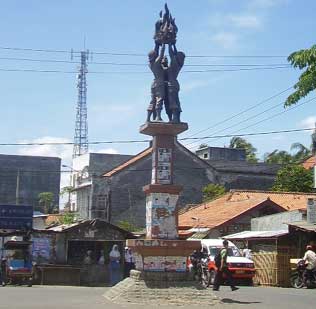Statue Not a Fitting Monument: Jakarta, West Java
For most people, the statue of three men holding a torch to the sky that is located in the middle of the intersection in front of the Mauk district administration and district military command buildings has no great symbolic meaning.
Almost all residents of Mauk — about 20 kilometers northwest of Soekarno-Hatta International Airport — do not know the name of the statue as Multa Fidrus explains:
“Locals only know it as tugu Mauk (or the Mauk monument), nothing more,” Sampan, a resident of Ketapang village, said.

Sampan who runs a household appliances store near the monument said he did not know the statue commemorated national hero Oto Iskandardinata, or Otista, who fought for the country’s independence through political movements.
District administration official Mardian said he was not aware of the story behind the monument either.
Otista led national youth movement Budi Utomo movement, as well as chairing the Pasundan youth organization between 1929 and 1942.
Mas Iman Kusnandar, an assistant at the Tangerang regency administration, recently published a book titled Dari Titian Sejarah Menuju Gerbang Pembangunan (From Historic Bridge to Development Gate).
In his book, Iman chronicled the long course of Otista‘s involvement in the movement against the colonial administration.
On Dec. 10, 1945, Otista is said to have been kidnapped from his house on Jl. Kapas in Jakarta by an unidentified group of young men claiming to be members of Laskar Hitam (the black brigade).
The abduction of prominent independence figures — aimed at disparaging the national movement — was not unusual in those days.
Otista was taken to an area called Tanah Tinggi in Tangerang municipality, before being moved to Ketapang village. On Dec. 20, 1945, his kidnappers executed him in Tosia hamlet near Ketapang.
However, the news of his abduction and death was only made public in the mid-50s. The kidnappers’ motive was never revealed.
“Therefore, out of respect for Otista and the fact he was slain in this village, HE Muchdi, Tangerang regent for the 1966-1978 period, decided to build the monument,” Iman said.
Unfortunately, the monument, which was once demolished and reconstructed, does not describe Otista‘s struggle at all.
“If a bust of Otista sat at the top of the monument it would be clear that it commemorated his fight,” resident Anwar Yassin said.
He said it was not a fitting monument and therefore had little historical value.
Multa Fidrus, The Jakarta Post, Tangerang